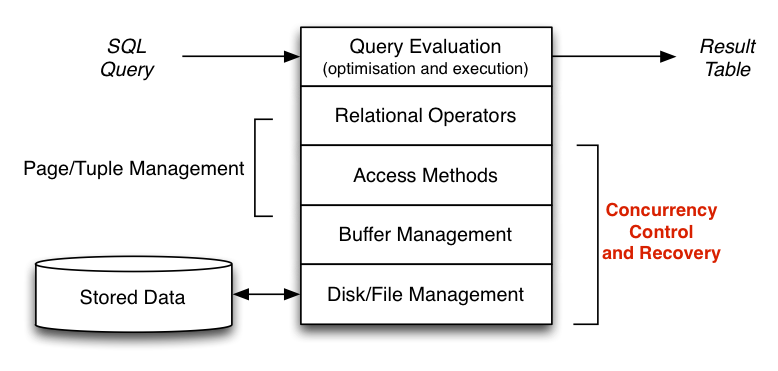Transaction Processing

Overview
A transaction (tx) is:
- A single application-level operation.
- Performed by a sequence of database operations.
A transaction affects a state change on the DB.

Transaction States

COMMIT ==> all changes preserved. ABORT ==> database unchanged.
Concurrency
Concurrent transactions are:
- Desirable for improved performance (throughput).
- Problematic, because of potential unwanted interactions.
To ensure problem-free concurrent transactions:
- Atomic: whole effect of tx, or nothing.
- Consistent: individual tx’s are “correct” (wrt. application).
- Isolated: each tx behaves as if no concurrency.
- Durable: effects of committed tx’s persist.
Transaction processing is the study of techniques for realising ACID properties.
Consistency
Consistency is the property:
- A tx is correct with respect to its own specification.
- A tx performs a mapping that maintains all DB constraints.
Ensuring this must be left to application programmers.
Atomicity
Atomicity is handled by the commit and abort mechanisms:
- Commit ends tx and ensures all changes are saved.
- Abort ends tx and undoes changes “already made”.
Durability
Durability is handled by implementing stable storage, via
- Redundancy: to deal with hardware failures.
- Logging/checkpoint mechanisms to recover state.
Isolation
Isolation is handled by concurrency control mechanisms:
- Possibilities: lock-based, timestamp-based, check-based.
- Various levels of isolation are possible (e.g. serialisation).
Transaction Terminology
To describe transaction effects:
- READ: transfer data from disk to memory.
- WRITE: transfer data from memory to disk.
- ABORT: terminate transaction, unsuccessfully.
- COMMIT: terminate transaction, successfully.
- BEGIN: starts a transaction.
- ROLLBACK: aborts the current transaction, undoing any changes.
Relationship between above operations and SQL:
- ``SELECT` produces READ operations on the database.
UPDATEandDELETEproduce READ then WRITE operations.INSERTproduces WRITE operations.
Formalising Transaction Operations
The READ, WRITE, ABORT, COMMIT operations:
- Occur in the context of some transaction
T. - Involve manipulation of data items,
X, Y.
The operations are typically denoted as:
R_T(X): read itemXin transactionT.W_T(X): write itemXin transactionT.A_T: abort transactionT.C_T: commit transactionT.
Schedules
A schedule gives the sequence of operations for more than 1 tx.
Serial schedule for a set of tx’s T_1, ... , T_n:
- All operations of
T_icomplete beforeT_{i + 1}. - Example:
R_{T_1}(A) W_{T_1}(A) R_{T_2}(B) R_{T_2}(A) W_{T_3}(C) W_{T_3}(B). - Guarantees DB consistency.
Concurrent schedule for a set of tx’s T_1, ... , T_n:
- Operations from individual
T_i’s are interleaved. - Example:
R_{T_1}(A) R_{T_2}(B) W_{T_1}(A) W_{T_3}(C) W_{T_3}(B) R_{T_2}(A). - Arbitrary interleaving may produce DB that is not consistent after all tx’s have committed successfully.
Transaction Anomalies
The set of problems with uncontrolled concurrent transactions can be characterised broadly under:
- Dirty read: reading data item written by concurrent uncommitted tx.
- Non-repeatable read: re-reading data item (row), since changed by another concurrent tx.
- Always the result of an
UPDATEoperation. - Can be prevented by locking rows.
- Always the result of an
- Phantom read: re-scanning result set (rows plural), finding it changed by another concurrent tx.
- Can be result of
UPDATE,INSERTorDELETEoperation. - Can be prevented by locking table.
- Can be result of